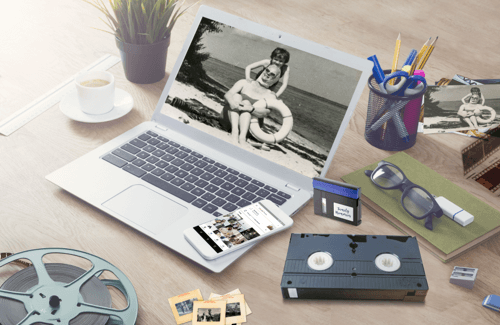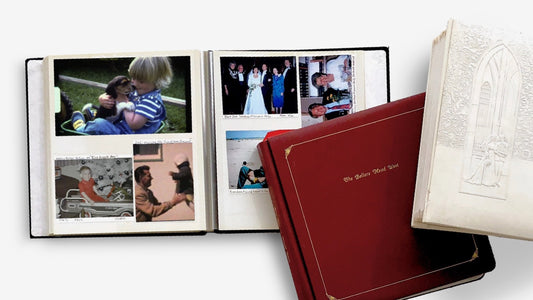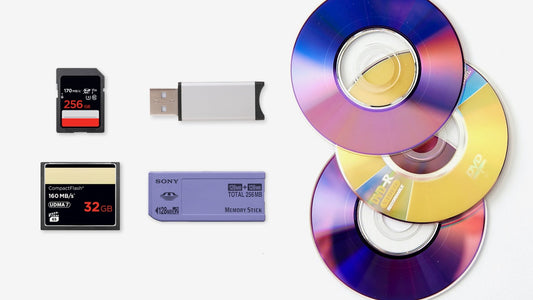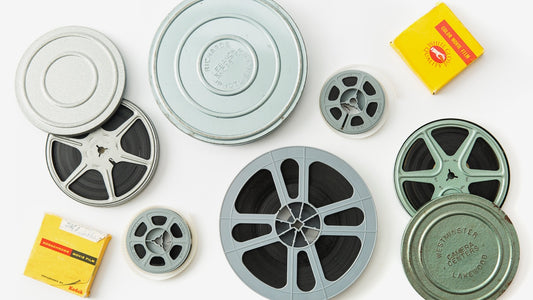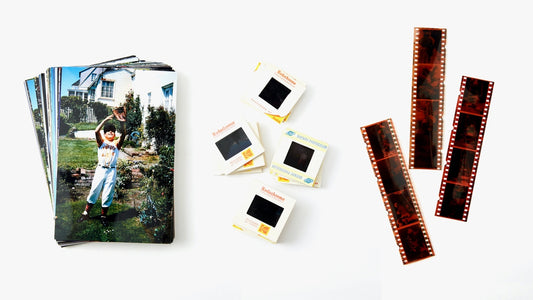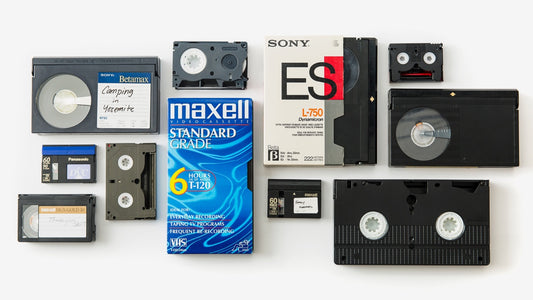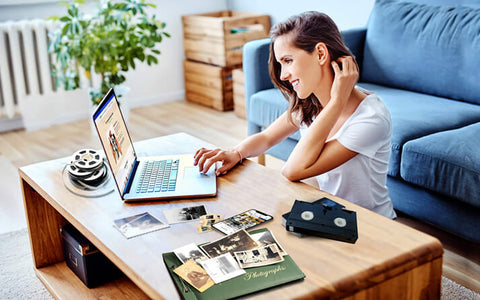Your family’s history isn’t just a collection of dates and names; it’s a story told through grainy home movies, faded photographs, and handwritten notes in old albums. But when those stories are trapped on obsolete formats, they risk being lost forever. Bringing them into the present day is about more than just a technical upgrade—it’s about ensuring your legacy can be seen and shared by future generations. The best way to do this is to convert analog media to digital, unlocking those moments for everyone to enjoy. This guide will provide a clear path forward, showing you how to safely preserve your family’s most important stories and create a lasting digital archive.
Key Takeaways
- Bring your old media into the present: Digitizing protects your memories from the natural decay of tapes and photos, unlocking them from dusty boxes and making them easy to watch, share, and enjoy on modern devices.
- Trust an expert for the best results: A professional service uses specialized equipment to create higher-quality digital files, saving you countless hours and protecting your irreplaceable originals from the risk of damage.
- Organize your digital library for the future: After conversion, create a simple folder system and a reliable backup plan—like one copy on a hard drive and another in the cloud—to ensure your memories are safe and easy to find for years to come.
Why Digitize Your Old Media?
If you have boxes of old videotapes, film reels, and photo albums tucked away in a closet or attic, you’re holding onto priceless pieces of your family’s story. But those physical formats won't last forever. Digitizing your old media is the best way to protect those moments and bring them back into your life. It’s more than just a technical upgrade; it’s about ensuring your family’s legacy can be seen, shared, and enjoyed for generations to come. By converting them to a digital format, you give your memories a permanent, safe home.
Preserve Your Family History
Physical media is fragile. Videotapes degrade, the magnetic tape becoming brittle and weak over time. Photos and slides fade, their vibrant colors turning dull and washed out. Every time you play an old tape or handle a delicate photo, you risk causing a little more damage. Converting your media now captures those memories exactly as they are today, stopping the process of decay in its tracks. A professional photo transfer service can save your pictures before they are lost forever, creating a lasting digital archive of your family’s most important moments.
Share and Enjoy Memories Anywhere
One of the best parts of digitizing your memories is how easy it becomes to share them. Instead of being stuck in a box, your family’s history can be at your fingertips. Imagine pulling up your parents’ wedding video on your phone at a family dinner or sending your childhood home movies to a sibling who lives across the country. Once your memories are digital, you can upload them to the cloud, post them on social media, or create custom gifts. Transferring your home movies makes it simple for everyone in the family to access and enjoy them, no matter where they are.
Protect Your Memories from Fading
Analog formats are susceptible to wear and tear, which leads to a loss of quality over time. The picture on a VHS tape can become grainy and distorted, while the audio can warp and fade. Old film reels can lose their color and clarity, making them difficult to watch. By converting to digital, you preserve the integrity of your media. The digital copy won’t degrade or lose quality with each viewing. It’s a perfect snapshot of your original media, safeguarding the sights and sounds of your favorite memories from the effects of time.
What Kinds of Memories Can You Digitize?
If you have a box of old media tucked away in a closet, you might be surprised by just how much of it can be converted into a modern digital format. From the home movies you watched on repeat to the shoeboxes full of family photos, nearly every type of analog media can be preserved. Digitizing these memories not only protects them from physical decay but also makes them incredibly easy to watch, share, and enjoy with your loved ones. Let’s look at the most common formats you can bring into the digital age.
Videotapes (VHS, Camcorder, and More)
Remember those chunky VHS tapes or the smaller cassettes from your old camcorder? Those tapes hold priceless moments, from birthday parties and holiday gatherings to school plays and family vacations. Formats like VHS, VHS-C, Betamax, Hi8, and MiniDV were the go-to for capturing life for decades. Unfortunately, the magnetic tape inside them degrades over time, causing colors to fade and the picture quality to worsen. A professional video transfer service can carefully convert these tapes, preserving the sights and sounds of your favorite home movies before they’re lost for good. It’s the perfect way to ensure future generations can enjoy them, too.
Old Film and Movie Reels
Before videotapes, families captured memories on film reels. If you’ve inherited canisters of 8mm, Super 8, or 16mm film, you’re holding some of your family’s oldest moving pictures. This film is delicate and can become brittle over the years, making it risky to run through an old projector. Specialized equipment is needed to handle these reels safely and scan them frame by frame. Getting a professional film transfer is the best way to protect these fragile heirlooms. Once digitized, you can watch silent films of your grandparents’ wedding or your parents as kids with incredible clarity, bringing history to life right on your screen.
Photos, Slides, and Photo Albums
Those stacks of photo prints, carousels of 35mm slides, and dusty photo albums are treasure troves of family history. Instead of letting them sit in a box, you can have them all scanned into high-quality digital files. A photo transfer service can handle loose prints, negatives, and slides, saving you hours of tedious work. Even better, you can preserve entire books of memories with album scanning, which keeps the original layout and handwritten notes intact. Once your photos are digitized, you can easily share them on social media, create custom photo books, or simply have a secure backup of every precious snapshot.
Audio Tapes and Cassettes
Don’t forget about the sounds of the past. Audio cassettes, micro-cassettes, and even reel-to-reel audio tapes often contain irreplaceable recordings. You might have a mixtape from your college days, a recording of your child’s first words, or an interview with a grandparent sharing their life story. Like videotapes, the magnetic tape on these audio formats can wear out over time, muffling the sound quality. While some DIY methods exist, using a professional service ensures you get the clearest possible audio from your original tapes. Digitizing these recordings means you can listen to those cherished voices and favorite songs for years to come.
Should You DIY or Use a Professional Service?
Deciding whether to digitize your old home movies and photos yourself or hand them over to a professional is a big first step. The DIY route can seem tempting, especially if you enjoy a good project and want to save a little money. It puts you in complete control, which can be really appealing. On the other hand, a professional service offers expertise and peace of mind, ensuring your irreplaceable memories are handled with care by people who do this every day.
The right choice really comes down to what you value most: your time, your budget, or the final quality of your digital memories. There's no single right answer, but understanding the trade-offs will help you make a decision you feel great about. Before you start pulling out old VCRs or pricing out scanners, let's walk through the key things to consider. We'll compare everything from the final picture quality to the true cost in both time and money, so you can feel confident in your choice.
Comparing the Final Quality
When you’re preserving memories, the quality of the final product is everything. While a DIY setup can get the job done, it often can’t match the clarity and vibrancy produced by professional-grade equipment. DIY VHS digitization, for example, can sometimes result in fuzzy video, distorted audio, or colors that just don't look right. This is usually because consumer-grade VCRs and converters can't capture the same level of detail as the specialized gear used by the pros.
A professional video transfer service uses calibrated, high-end equipment to ensure every frame is captured with precision. This means a more stable picture, better color accuracy, and clearer sound, giving your old memories the modern look they deserve.
What's the Real Cost?
At first glance, the DIY approach might seem like the cheaper option, but the costs can add up quickly. First, you’ll need the right equipment. If you don’t have a working VCR, camcorder, or film projector, you’ll have to find and buy one. Then, you’ll need a digital conversion device to connect it to your computer, plus the right software to capture and edit the files.
When you factor in the price of all the necessary gear and the value of your own time, the cost can easily surpass that of a professional service. With a service like YesVideo, you get a clear, upfront price. It’s an investment that saves you from buying equipment you might only use once and protects you from the costly risk of damaging your original tapes or film.
How Much Time Will It Take?
Digitizing media is a real-time process, which is something many people don't realize until they're deep into it. A two-hour videotape will take at least two hours to capture on your computer. Now, multiply that by the number of tapes in your collection. Add in the time for setup, troubleshooting technical glitches, editing, and organizing the final files, and you’re looking at a project that can take up dozens, if not hundreds, of hours.
Using a professional service transforms this time-intensive task into a simple one. You just need to pack up your media and send it in. While the turnaround time might be a few weeks, you’re freeing yourself from countless hours spent in front of a computer.
The Tools and Skills You'll Need
To successfully digitize your own home movies, you’ll need more than just a bit of patience. First, you need working playback equipment that matches the format of your media, whether it’s a Betamax player, a Hi8 camcorder, or an 8mm film projector. Finding these devices in good working condition can be a challenge in itself.
Next, you’ll need a video capture adapter to connect the player to your computer and software to record the digital file. This process requires a bit of technical know-how to get the settings right for the best quality. If you’re dealing with delicate formats like old movie reels, a professional film transfer is often the safest bet to avoid any technical headaches.
Common DIY Roadblocks
One of the biggest risks with a DIY project is the potential for damaging your original media. Old tapes and film reels are incredibly fragile. A dusty, aging VCR can easily chew up a brittle VHS tape, and mishandling film can lead to permanent scratches. These are your only copies, so a mistake can mean losing a memory forever.
Beyond physical damage, you might run into technical issues like corrupted digital files, poor audio syncing, or software that just won’t cooperate. It can be incredibly frustrating to spend an entire weekend working on a project only to end up with a low-quality or unusable digital file. These common roadblocks are why many people ultimately decide to trust an expert.
Ensuring Your Memories Look Their Best
Professional digitization services bring a level of experience and technology that’s hard to replicate at home. Experts in the field know how to handle fragile, aging media with the utmost care. They use commercial-grade equipment that not only captures high-quality video but can also help correct common issues like color fading and shaky footage.
Services like YesVideo often include manual review and basic enhancements to make sure your memories look their best. This expertise ensures that your videos are converted with precision and care. It’s the peace of mind that comes from knowing your family’s history is in the hands of people who do this every single day.
How to Choose a Digitization Service
Handing over a box of your family’s most precious memories can feel like a huge leap of faith. You’re not just sending off old tapes and photos; you’re trusting someone with irreplaceable moments. That’s why choosing the right digitization service is so important. It’s about more than just finding the lowest price—it’s about finding a partner you can count on to treat your memories with the same care you would.
When you start looking, you’ll want to compare a few key things: their experience, the technology they use, how they keep your media safe, and what your final digital files will look like. It’s also smart to check out their customer support and get a clear picture of the total cost. Thinking through these points will help you find a service that not only delivers beautiful digital copies but also gives you complete peace of mind throughout the entire process. The goal is to find a company that offers the perfect blend of quality, security, and value, ensuring your memories are preserved for generations to come.
Look for Proven Experience
When it comes to preserving memories, experience is everything. A company that has been around for years has likely handled every type of tape, film, and photo format imaginable—including the fragile or obscure ones. They’ve refined their process and know how to manage potential issues, like a delicate film reel or a worn-out videotape. Look for a service with a long history and a solid track record. Reading customer reviews and testimonials can give you a great sense of their reliability and the quality of their work. A company with decades of experience is a good sign they’ve built a trusted reputation for a reason.
Check Their Technology and Standards
The quality of your digital memories depends entirely on the equipment used to create them. A professional service should use high-quality, well-maintained technology to ensure your videos and photos are captured with clarity and accurate color. Don’t be afraid to ask about their process. Reputable companies are usually happy to explain how they perform a video transfer or scan your photos. The right technology ensures that the digital version is a faithful representation of the original, preserving its character without losing detail. This step guarantees your memories look just as good on a screen as they did years ago.
How They'll Keep Your Memories Safe
This is probably the biggest question on your mind: are my memories safe? A trustworthy service will have a clear and secure process from start to finish. Find out how they track your order—many top services provide a tracking number so you can follow your media’s journey. It’s also important to know if the work is done in-house. Services that handle everything on-site, by hand, can offer a higher level of security and quality control. Knowing your precious photo albums and tapes are in a secure facility, handled by trained technicians, provides invaluable peace of mind.
Understand Your Digital File Options
Once your memories are digitized, how will you receive them? Most services offer a few different options, and it’s good to know what they are ahead of time. You might get your files via a cloud download, on a USB drive, or even on DVDs. Think about how you plan to use your new digital library. If you want to easily share photos and videos online, a cloud download is perfect. If you want a physical backup, a USB is a great choice. A good service will provide flexible options so you can access, share, and store your memories in a way that works best for you.
Make Sure You Can Get Help
Great customer support is a must. What happens if you have a question about your order or need help downloading your files? You want to choose a company that’s easy to reach and ready to help. Before you commit, check their website for a phone number, email address, or customer service chat. A company that makes it easy to get in touch with a real person shows that they care about their customers’ experience. This support can be incredibly reassuring, especially when you’re dealing with something as personal as your family’s history.
Breaking Down the Price
While you don’t want to choose a service based on price alone, it’s obviously an important factor. Look for a company with a clear, transparent pricing structure. Be wary of deals that seem too good to be true, as they might come with hidden fees or compromises in quality. Make sure you understand what’s included in the quoted price. Are there extra charges for things like repairing a broken tape or for getting your files on a USB drive? Finding a service that offers upfront pricing helps you avoid surprises and ensures you’re getting great value for preserving your memories.
How to Prep Your Tapes, Film, and Photos
Getting your memories ready for their digital journey is a crucial first step. A little prep work on your end can make a huge difference in the final quality of your digitized files. It ensures that the professionals have the best possible source material to work with, helping to preserve every detail. Think of it as lovingly packing a precious gift before sending it off. Taking these simple steps will help protect your tapes, film, and photos and set them up for a successful conversion.
First, Organize Your Collection
Start by gathering all your media in one place. Group similar formats together—all the VHS tapes in one pile, camcorder tapes in another, and so on. This will help you get a clear picture of what you have. If you have the old equipment and it’s still working, you might want to spot-check a few tapes to see what’s on them. Labeling is your best friend here; use sticky notes or a simple numbering system to identify what’s on each tape, reel, or box of slides. This not only helps you keep track but also allows you to give the digitization service specific instructions. Knowing what you have makes the video transfer process smoother from start to finish.
Gently Clean and Inspect Your Media
Before you pack everything up, take a moment to inspect your media for dust, dirt, or damage. For photos and slides, you can gently wipe away surface dust with a soft, lint-free cloth. Avoid using any liquids or cleaning chemicals, as they can cause permanent damage. For tapes and film, a visual check is usually best. Look for signs of mold, brittle tape, or cracked casings. If you notice any significant damage, don't try to fix it yourself. Mishandling fragile media can make things worse. It’s much safer to let the experts handle it. A professional photo transfer service has the right tools and experience to safely clean and prepare your delicate memories for scanning.
Tips for Handling with Care
Your memories are fragile, so it’s important to handle them with care during the sorting and packing process. When dealing with film reels or slides, always hold them by the edges to avoid getting fingerprints on the image area. The oils from your skin can degrade the film over time. For videotapes, avoid touching the magnetic tape itself. The same goes for the surface of photographs. Keep all your media away from strong magnetic fields (like speakers or electronics), direct sunlight, and extreme temperatures or humidity. These simple precautions can prevent accidental damage and ensure your memories arrive at the digitization lab in the best possible condition for a high-quality film transfer.
How to Store Everything Safely
Once you’ve organized and inspected your collection, you’ll need a safe place to keep it while you prepare to send it off. The best environment is a cool, dark, and dry location, like a closet in the main part of your house. Avoid attics, basements, or garages, where temperature and humidity can fluctuate dramatically and cause damage. Store tapes upright like books on a shelf to prevent stress on the film. This careful storage is a great temporary solution, but remember that all analog media degrades over time. The ultimate way to protect your memories for the long haul is to digitize them, converting everything from old home movies to entire photo albums into lasting digital files.
What Happens During the Conversion Process?
Handing over a box of your family’s most precious memories can feel like a leap of faith. You might be wondering, what exactly happens behind the scenes? It’s not just a simple copy-and-paste job. When you trust a professional service, your media goes through a careful, multi-step process designed to protect your originals while creating the best possible digital versions.
From the moment your collection arrives, every tape, reel, and photo is treated with the respect it deserves. Technicians combine specialized equipment with years of hands-on experience to gently bring your memories into the digital age. Let’s walk through what you can expect after you’ve sent your memories off for their digital makeover.
The Initial Assessment
Before any conversion begins, your media gets a thorough check-up. A trained technician will carefully inspect each item by hand to assess its condition. They’re looking for any signs of aging or damage—like brittle film, snapped tape, or dust and debris—that could affect the transfer quality. This initial assessment is crucial because the final digital copy’s quality is directly tied to how well the original has held up over the years. This step helps determine the best approach for digitizing each specific item and flags anything that might need a little extra care or minor repair before the real work begins.
How Pros Ensure High Quality
This is where professional expertise really shines. Digitization services use commercial-grade equipment that’s far more advanced than anything you could buy for home use. But the real magic comes from the people operating it. Experienced technicians bring a wealth of knowledge to the table, ensuring your memories are handled with precision and care. They know how to adjust settings to get the best color and sound from a faded videotape transfer and how to handle delicate, aging film reels without causing damage. This combination of professional-grade technology and human expertise is what guarantees a high-quality result that truly honors your original memories.
What to Expect for a Timeline
Good things take time, and the same is true for quality digitization. While it’s natural to be excited to see the final results, it’s important to have realistic expectations for the timeline. The entire process, from receiving your order to shipping it back, typically takes several weeks. This isn't because your box is sitting on a shelf; it's because every single item is processed by hand. This careful, deliberate approach includes inspection, cleaning, the actual digitization, and a final quality review to ensure everything looks and sounds great. This meticulous process ensures your memories get the individual attention they deserve.
Tracking Your Order from Start to Finish
One of the biggest benefits of using a trusted service is the peace of mind that comes with transparency. You should never have to wonder where your memories are or what’s happening to them. Reputable companies provide a robust tracking system that lets you follow your order’s journey every step of the way. You’ll receive email updates when your box arrives at the facility, as it moves through the digitization process, and when it’s safely on its way back to you. This clear communication ensures you feel connected and confident from start to finish, knowing your memories are in safe hands.
Optional Touch-Ups and Edits
While digitization can’t magically fix severe damage like mold or decay, technicians can often perform minor repairs to get your media in working order. For example, they can often mend simple breaks in film or videotape. Beyond basic transfers, many services also offer ways to make your new digital library even more enjoyable. This could include organizing your scanned photos into beautiful digital photo albums or creating highlight reels from hours of home movie footage. These thoughtful touches help transform a collection of old media into a shareable, organized library that your family can enjoy for years to come.
How to Manage Your New Digital Library
You’ve successfully digitized your precious memories—congratulations! The most delicate part of the process is over. Now comes the fun part: organizing and sharing your new digital library so you and your family can enjoy it for years to come.
Managing digital files might sound technical, but it’s really about creating a simple, safe home for your photos and videos. A little bit of organization now will make it easy to find that specific clip from a '90s family vacation or a photo from your grandparents' wedding whenever you want to take a trip down memory lane. Let’s walk through a few simple steps to store, back up, and share your newly preserved history.
Where to Store Your Digital Memories
The best place to store your memories is somewhere that is both secure and easy to access. Using a cloud storage service like Google Drive, Dropbox, or iCloud is a fantastic option. Storing files in the cloud gives your family a central place to view everything without you having to email large files back and forth. They can simply click a link to watch videos or download their own copies. For extra security, you can also keep a copy on a physical device, like an external hard drive that you store in a safe, dry place.
Create a Foolproof Backup Plan
Forgetting to back up your files is one of the most common mistakes, and it can lead to accidentally losing everything. A great rule of thumb is the 3-2-1 backup strategy: keep at least three copies of your files, on two different types of media, with one copy stored off-site. This is easier than it sounds! You could have one copy on your computer's hard drive, a second on an external hard drive, and a third in the cloud. This approach ensures that even if one copy is lost or damaged, your memories are still safe and sound.
Choose the Right File Formats
When you receive your digital files, you want to be sure you can actually watch and view them on your devices—now and in the future. Choosing the wrong format can lead to compatibility issues. That’s why professional digital media transfer services use widely supported formats like MP4 for video and JPEG for photos. These are standard formats that work on nearly all computers, phones, and smart TVs, so you won’t need special software to press play. Sticking with these universal formats makes sharing and long-term preservation much simpler.
Organize Your Digital Files
Now you can finally get everything in order. Start by creating a main folder on your computer or cloud drive called “Family Memories.” Inside that, create subfolders organized in a way that makes sense to you. Many people find organizing by year to be the easiest method. You can create folders for each year (e.g., "1980s," "1990s") and then create folders inside those for specific events, like “1995 - Summer Vacation” or “1998 - Christmas.” Take a few minutes to rename files with descriptive titles so you can find exactly what you’re looking for with a quick search.
Easy Ways to Share with Family
One of the greatest joys of digitizing your memories is sharing them with loved ones. Cloud storage makes this incredibly easy. You can share an entire folder of digitized photos with a single link, allowing family members to browse and download their favorites. You can also create digital photo albums, make slideshows for family gatherings, or share clips on social media. For relatives who aren't as tech-savvy, loading the files onto a USB drive and mailing it to them is a thoughtful and simple way to share.
Tips for Long-Term Preservation
Unlike analog tapes and film reels that degrade over time, digital files preserve the quality of your memories indefinitely. However, technology is always changing. To ensure your files remain accessible for future generations, it’s a good idea to do a quick check-in every few years. Make sure your backup copies are still in good shape and consider moving your files to newer storage devices (like a new external hard drive) every five to ten years. This simple maintenance ensures your family’s legacy remains protected and viewable, no matter what new devices come along.
Related Articles
- 8 Best Companies to Digitize Your Home Movies – YesVideo
- Media Conversion Service Guide
- Digital Conversion Service Guide
- Transfer Slides to Digital
- Picture Scanning Service Guide
Frequently Asked Questions
Will I get my original tapes, film, and photos back? Absolutely. Every single original you send us is carefully handled throughout the process and returned to you along with your new digital copies. We understand that these items are irreplaceable, and our entire system is designed to track and protect your collection from the moment it arrives until it’s safely sent back home.
What if some of my tapes are broken or I don’t know what format they are? Don't worry, that’s a very common situation. Our technicians are trained to handle a wide variety of issues and can often make minor repairs, like fixing a snapped videotape, to make it playable for conversion. You also don’t need to be an expert on media formats. Just send in what you have, and our team will identify the formats for you and digitize everything they can.
How do I know my memories are safe during the process? We know that sending your memories away requires a lot of trust. That’s why we have a secure system that tracks your order with a unique number every step of the way. All the work is done by hand in our own US-based facility, never outsourced. You’ll receive email updates as your order moves through our lab, so you have peace of mind knowing exactly where your memories are.
How long does the digitization process usually take? Quality work takes time, and since every item is processed by hand, you can typically expect the process to take a few weeks. This timeline allows our technicians to carefully inspect, clean, and digitize each memory with the individual attention it deserves. This meticulous approach ensures we create the best possible digital version of your family’s history.
What’s the best way to organize my media before sending it in? A little organization can go a long way. The simplest method is to group similar items together—put all your VHS tapes in one bag, your photo prints in another, and so on. If you want to label specific tapes or reels with titles like "Christmas 1992," you can use a sticky note or a piece of paper. This helps you keep track of your collection and ensures the final digital files are easy to identify.





